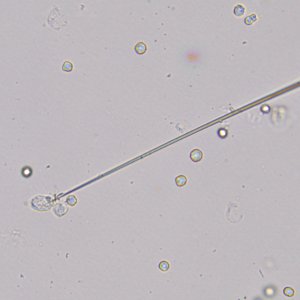microcapillariesMicrocapillaries are essentially microscopic glass needles that can be used for a variety of uses in biology. By varying the shape of a needle and the size of the needle's tip, these needles can be used for anything from injecting DNA into individual cells to detecting the flow of ions in and out of a cell. At Biofrontiers, we used needles with a large (~10 um) tip to pick up whole cells and manipulate them (cell capture). We also used needles similar to the one pictured below to genetically modify fruit fly embryos.
A particularly sharp and narrow needle. The first image is from a normal optical transmission microscope and shows the needle forming some nice rainbow patterns next to some cells. The second image was taken on a scanning electron microscope and shows that the tip of this particular needle is just 900nm across.
Surprisingly, these incredibly small geometries are made simply by heating up a glass tube and pulling the ends of the tube apart. When pulled like this, the glass tube stretches and narrows in diameter significantly - once it's thin enough, the tube is broken by cooling the glass and continuing to pull. Needles can be made almost arbitrarily sharp using this simple process. At Biofrontiers, we owned our own machine to make needles, which allowed for much more control over needle geometry than purchasing pre-made needles. However, the needles that are made with this machine are extremely sensitive to the 'recipe' of machine parameters (pulling velocity, heat, etc.) used, and it often took 50+ failed needles before we found a recipe that produced the desired result. Once the correct recipe is found, however, it can be used over and over again to produce as many needles as desired.
I will try to post more images of the microcapillaries and how we made them soon, but right now these are the only images I have of needles from the Biofrontiers lab.




